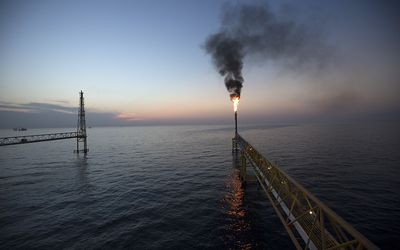China switching to African oil may lead to Saudi price cut
by Clyde Russell,
2015-07-28 17:30:52.0
LAUNCESTON, AUSTRALIA — Weakness in global oil benchmark Brent has prompted China to buy more crude from Africa.
The question now is how will top exporters Saudi Arabia and Russia respond to the shifting dynamics?
Chinese imports from Africa are expected to jump to 6.51-million-tonnes (47.5-million barrels) in July, up about 41% from June, according to data compiled by Thomson Reuters Oil Research and Forecasts.
The bulk of the increase will come from Angola, China’s top supplier in Africa, which is expected to ship 3.4-million-tonnes in July, up from 2.88-million in June, the forecast team said.
Also gaining are cargoes from South Sudan, with eight exported to China in July for a total 767,000-tonnes, an increase of 8% from June.
For the Angolans, the large boost in July exports to China will be a welcome change, as they lost their number-two spot behind Saudi Arabia in the first six months of 2015 to Russia, according to Chinese customs data.
China imported 19.011-million-tonnes from Angola in the first half of 2015, a drop of 8.7% from the same period last year.
Imports from Russia were 19.401-million tonnes, a leap of 26.6%, while Saudi Arabia boosted shipments to 26.386-million-tonnes, a gain of 9.2%. However, Thomson Reuters Oil Research expects Saudi Arabia’s market share for Chinese imports to drop from 35% in June to 31% in July, while Russia’s seaborne shipments to China are expected to drop 300,000-tonnes to about 1-million.
It isn’t hard to work out the dynamics that have driven the shift in Chinese buying patterns in July.
Crudes priced off Brent, such as those from Angola, have become cheaper relative to those priced off Dubai, such as Saudi grades and Russia’s ESPO.
The Brent-Dubai exchange for swaps, which measures Brent’s premium over Dubai crude, was $1.31 a barrel on Monday, up from the low this year of 61c on July 8.
However, it’s still well below the $2.27 a barrel from May 22, and only a little more than a quarter of the 2014 peak of $4.94, reached last June.
Brent’s premium to Dubai has been on a downward trend since September 2013, when it reached $7.10 a barrel.
That hasn’t resulted in a wholesale switch to Brent-priced grades by Asian buyers as many of the new, complex refineries are designed to run on heavy, sour crudes typical of Middle East grades.
But it has improved the economics of using more crudes similar to Brent, and also buying them to fill strategic storages.
Saudis may cut official prices
This suggests that if the Saudis and the Russians wish to ensure they maintain market share in China, which vies with the US as the world’s top importer, they will have to ensure their prices are competitive.
Which means the Saudis may cut their official selling prices (OSP) for crudes for Asian refiners when September-loading prices are released early in August.
The OSP for benchmark Saudi Arab light crude was lowered to a discount of 10c a barrel to Oman/Dubai crude for August cargoes, having been at par for July.
However, the Saudis had gradually been raising the OSP in recent months, from a discount of $2.30 a barrel for March cargoes to par by July.
This was most likely done as refining margins in Asia remained relatively strong and the premium of Brent over Dubai tracked largely sideways.
But refinery margins have been easing in recent weeks, with a typical Singapore refinery making $5.89 from a barrel of Dubai crude currently, down from $8.12 for June and the 2015 peak of $9.33 for March.
With weaker refinery margins, cheaper Brent relative to Dubai and the threat of rising shipments from Iran as a result of the Islamic Republic’s nuclear deal with world powers, it seems the Saudis may have to renew their discounting efforts to maintain market share in Asia, their largest market.
Reuters

Pemex. Picture: BLOOMBERG/SUSANA GONZALEZ
LAUNCESTON, AUSTRALIA — Weakness in global oil benchmark Brent has prompted China to buy more crude from Africa.
The question now is how will top exporters Saudi Arabia and Russia respond to the shifting dynamics?
Chinese imports from Africa are expected to jump to 6.51-million-tonnes (47.5-million barrels) in July, up about 41% from June, according to data compiled by Thomson Reuters Oil Research and Forecasts.
The bulk of the increase will come from Angola, China’s top supplier in Africa, which is expected to ship 3.4-million-tonnes in July, up from 2.88-million in June, the forecast team said.
Also gaining are cargoes from South Sudan, with eight exported to China in July for a total 767,000-tonnes, an increase of 8% from June.
For the Angolans, the large boost in July exports to China will be a welcome change, as they lost their number-two spot behind Saudi Arabia in the first six months of 2015 to Russia, according to Chinese customs data.
China imported 19.011-million-tonnes from Angola in the first half of 2015, a drop of 8.7% from the same period last year.
Imports from Russia were 19.401-million tonnes, a leap of 26.6%, while Saudi Arabia boosted shipments to 26.386-million-tonnes, a gain of 9.2%. However, Thomson Reuters Oil Research expects Saudi Arabia’s market share for Chinese imports to drop from 35% in June to 31% in July, while Russia’s seaborne shipments to China are expected to drop 300,000-tonnes to about 1-million.
It isn’t hard to work out the dynamics that have driven the shift in Chinese buying patterns in July.
Crudes priced off Brent, such as those from Angola, have become cheaper relative to those priced off Dubai, such as Saudi grades and Russia’s ESPO.
The Brent-Dubai exchange for swaps, which measures Brent’s premium over Dubai crude, was $1.31 a barrel on Monday, up from the low this year of 61c on July 8.
However, it’s still well below the $2.27 a barrel from May 22, and only a little more than a quarter of the 2014 peak of $4.94, reached last June.
Brent’s premium to Dubai has been on a downward trend since September 2013, when it reached $7.10 a barrel.
That hasn’t resulted in a wholesale switch to Brent-priced grades by Asian buyers as many of the new, complex refineries are designed to run on heavy, sour crudes typical of Middle East grades.
But it has improved the economics of using more crudes similar to Brent, and also buying them to fill strategic storages.
Saudis may cut official prices
This suggests that if the Saudis and the Russians wish to ensure they maintain market share in China, which vies with the US as the world’s top importer, they will have to ensure their prices are competitive.
Which means the Saudis may cut their official selling prices (OSP) for crudes for Asian refiners when September-loading prices are released early in August.
The OSP for benchmark Saudi Arab light crude was lowered to a discount of 10c a barrel to Oman/Dubai crude for August cargoes, having been at par for July.
However, the Saudis had gradually been raising the OSP in recent months, from a discount of $2.30 a barrel for March cargoes to par by July.
This was most likely done as refining margins in Asia remained relatively strong and the premium of Brent over Dubai tracked largely sideways.
But refinery margins have been easing in recent weeks, with a typical Singapore refinery making $5.89 from a barrel of Dubai crude currently, down from $8.12 for June and the 2015 peak of $9.33 for March.
With weaker refinery margins, cheaper Brent relative to Dubai and the threat of rising shipments from Iran as a result of the Islamic Republic’s nuclear deal with world powers, it seems the Saudis may have to renew their discounting efforts to maintain market share in Asia, their largest market.
Reuters




















Post a comment